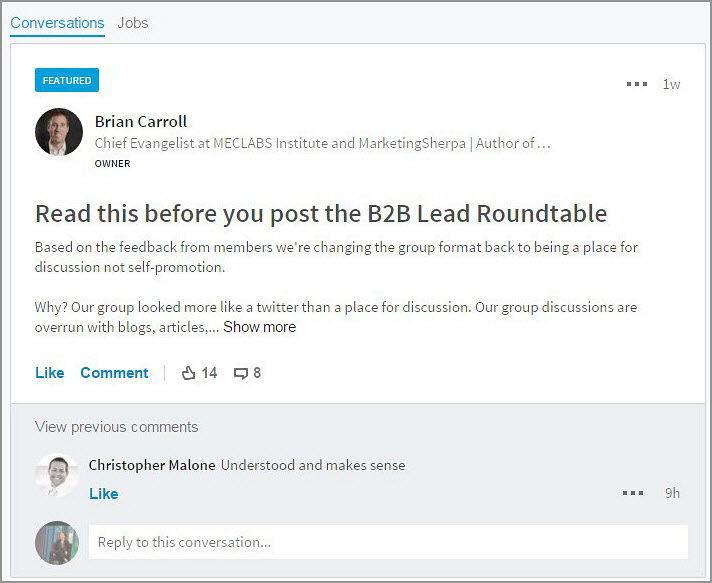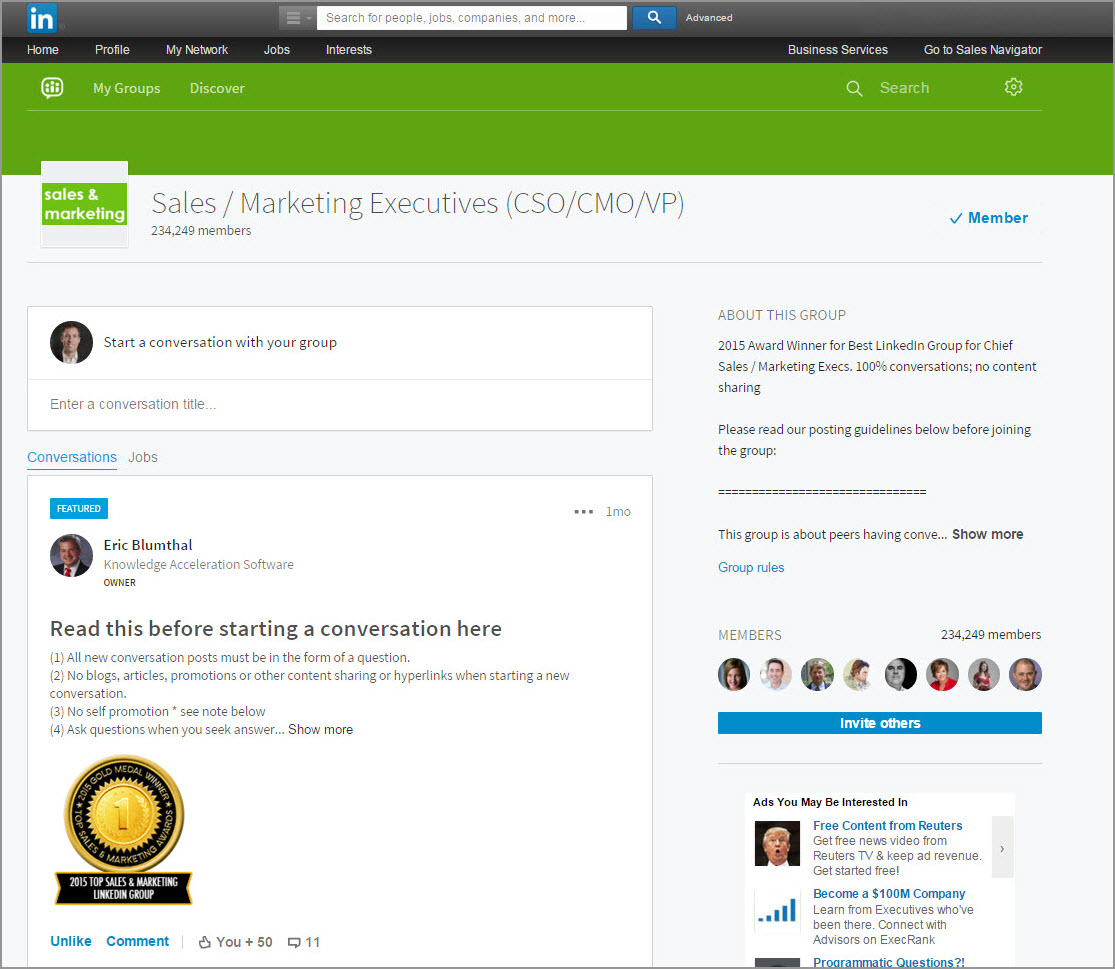From 0 to 233,000 Members: 7 steps to running an effective LinkedIn group
LinkedIn groups are one of the many helpful aspects of the professional community available on the platform. It can help you to build connections, get questions answered, share your expertise and demonstrate thought leadership.
With this in mind, I started the B2B Lead Roundtable Group to be a community for people to learn and discuss the many facets of B2B lead generation. However, over time, I noticed that our group discussions started to look more like Twitter feed. Discussions became overrun with blogs, articles and other content sharing and hyperlinks but there was no discussion happening.
It was time for a change. As I was researching I came across Eric Blumthal and his group “Sales / Marketing Executives Forum” which boasts over 233,974 members and was voted “Best LinkedIn Group for Sales / Marketing Executives” by several publications. And this group is 100% discussion, no link sharing.
Eric’s the CEO of count5, an acceleration software platform that reinforces the impact of employee training and communications.
I reached out to Eric Blumthal to find out his secret to building a LinkedIn community. I was interested in learning how he built such a vibrant community and discover what really works.
The conversation below is extracted from an email interview between Eric and myself:
Brian: How did you develop this approach to your LinkedIn group?
Eric: I love live networking. Always have. And I am good at it. What makes me good at it? I always make it about them and not about me. No one likes getting pitched at a networking event. I like people; I want to get to know them. I want to figure out ways to help them (introductions, information, etc.); [it’s] all about adding value. Over time, relationships are formed. Over time, trust is formed. And over time, things come around full circle and people help me too.
Quick story — several years ago, I was at a monthly CXO networking event at the Ritz Carlton in Atlanta. I loved this event because it was nothing but smart business executives. I always learned something just by listening to what they said. At this night’s event, I found myself in a very compelling conversation with four other executives. We were having a great exchange until BOOM! Here comes the Annoying Guy.
The Annoying Guy (is what we called him for the rest of the night) squeezes into our little huddle, interrupts our conversation, distributes cards to everyone, gives his exhausting 30-second elevator pitch and walks away. We all laughed; there is no way Annoying Guy has ever been successful with that approach. It made me wonder how long he has been doing this and how long he will continue until he learns his lesson.
At home later that evening, I logged into LinkedIn and went to a few groups I belonged to so I could post some interesting information. I posted a link to my company website with a little call-to-action. I did that every couple days — and had been for quite a while. Thought it was pretty smart. Then I felt nauseous, making the realization that on LinkedIn I was no better than the annoying guy at the Ritz event — I was just an electronic version of him.
This was an epiphany for me and changed the way I approach social media. Now I treat social networking the same way I treat live networking. Make it about them; add value. Help when you can; no pitching.
What inspired you to start your LinkedIn Group Sales/Marketing Executives (CSO/CMO/VP)?
Everything I found for B2B sales and marketing in LinkedIn, Twitter and Facebook looked like an RSS feed of articles, blogs and promotions. While I am a fan of content marketing and a fan of finding valuable content, I felt the outlets for content distribution were oversaturated and noisy. There didn’t seem to be a place where smart sales and marketing executives could meet to share ideas, to ask questions and to learn from each other’s experiences.
I wanted to provide a framework where this could take place.
How have you come to run such an effective group?
Member involvement is what makes this an effective group. If members aren’t asking questions or sharing their experiences and thought leadership, there is no group.
When we first got the group going, I set up a series of conference calls with members and ask them what they liked, what they didn’t like and what they hoped for from this group. We used this feedback as a basis to set the group’s tone. Also, involving the membership gave them a sense of ownership as well which motivated more participation. Every year, we learn more about what’s working and what’s not, and we adjust accordingly.
The other requirement is proactive group moderation. The group moderators and I donate several hours per week ensuring the forum stays valuable and spam-free. We have to be passionate about keeping this valuable to continue the time commitment required each week of each year.
What inspired your rules to be discussion-only when so many other groups are clogged with posts?
I really like Quora.com, which provides a question/answer framework that is 100% focused on helping people and learning from them. We modeled our rules after this to keep the forum noise-free.
Every month someone complains about the rules being too prohibitive, but I explain to them the valuable content shared in our group is in the form of members exchanging ideas with each other instead of blogs. If you want to post a blog or an article, go to Twitter or Pulse. If you want to share your thought leadership, then add value by answering a question.
There is room for everyone and every agenda in social media. We have a very specific agenda. And at over a quarter million members, I think we’ve carved out a nice niche.
What have you learned from running your group?
I’ve learned you have to figure out what you want out of social networking because otherwise you are just going through the motions.
I’ve learned social networking, like live networking, requires passion and a commitment of time before you see any return on your investment. You get out what you put in.
How has starting your group benefited you personally/professionally?
I’ve also learned social media makes the world much smaller. I’ve gotten to know so many interesting people from all over the world. Some of them I consider true friends.
Financially, I can directly attribute over a half million of my company’s recurring software revenue to people I met in the group.
Any success stories from group members?
I love helping people. Every week I receive messages and calls from people I don’t know thanking me for being different and for the value they get from the forum. This is very fulfilling and keeps me motivated.
Also there are many stories of how members got jobs or customers from relationships they have made from participating in the forum.
In conclusion, what are some tips/advice would you would give to running an effective LinkedIn group?
- You do not have to start a group to benefit from groups. All you have to do is participate. Ask questions; answer questions [and] send people private messages when you found their insights valuable.
- Name your group wisely. Names matter because the name of your group will attract your audience. Keep in mind when people are searching for a group in LinkedIn, it will benefit you to keep those search terms in mind when naming your group. And unless you are salesforce.com or IBM, don’t name your group after your company — no one will join. Trust me, I tried it.
- Why will people join? What does the group need to have to make people want to spend time there? Ask some people if you don’t know.
- Lonely groups stay lonely. If you build it, they won’t come if there is nothing happening in the group. I made sure a couple of consultants and friends I knew were willing to join the group pre-launch and start some interesting discussions so once I invited people it looked like there was actual activity.
- Launch and learn. Be willing to make mistakes; just make sure to learn from them.
- Be patient and prioritize. This is a long term commitment. It requires discipline and patience. Never forget you have much higher priorities that make you successful that have nothing at all to do with LinkedIn. Social media can become a huge time suck if you are not prioritized and disciplined with your time.
- Be yourself. Seriously — this is social networking. Be yourself; don’t try to be someone you’re not. People are on LinkedIn because they want to connect with real people.
You can follow Brian Carroll on Twitter at @brianjcarroll.
You might also like
How to use LinkedIn Generate Leads [From the B2B Lead Blog]
Marketing to Millennials: Are we still just selling snake oil?
Live From MarketingSherpa Summit 2016: Morgan Spurlock and using storytelling in your campaigns
Categories: B2B Marketing case study, job hunting, LinkedIn, LinkedIn group, networking, professional











